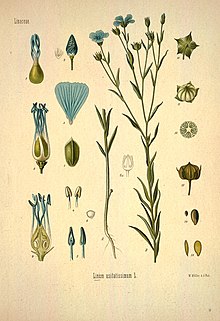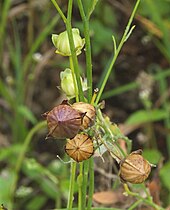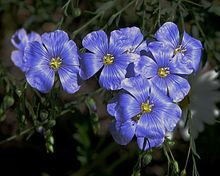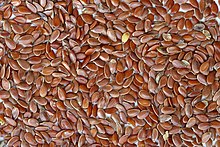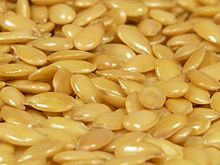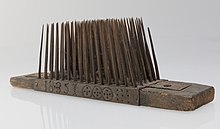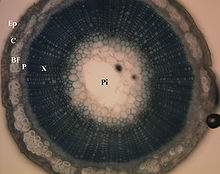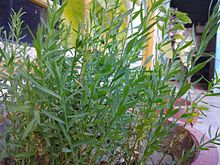Omega−3 fatty acids, also called Omega−3 oils, ω−3 fatty acids or n−3 fatty acids, are polyunsaturated fatty acids (PUFAs) characterized by the presence of a double bond, three atoms away from the terminal methyl group in their chemical structure. They are widely distributed in nature, being important constituents of animal lipid metabolism, and they play an important role in the human diet and in human physiology. The three types of omega−3 fatty acids involved in human physiology are α-linolenic acid (ALA), eicosapentaenoic acid (EPA) and docosahexaenoic acid (DHA). ALA can be found in plants, while DHA and EPA are found in algae and fish. Marine algae and phytoplankton are primary sources of omega−3 fatty acids. DHA and EPA accumulate in fish that eat these algae. Common sources of plant oils containing ALA include walnuts, edible seeds, and flaxseeds as well as hempseed oil, while sources of EPA and DHA include fish and fish oils, and algae oil.

Linen is a textile made from the fibers of the flax plant.
Essential fatty acids, or EFAs, are fatty acids that humans and other animals must ingest because the body requires them for good health, but cannot synthesize them.

α-Linolenic acid, also known as alpha-linolenic acid (ALA), is an n−3, or omega-3, essential fatty acid. ALA is found in many seeds and oils, including flaxseed, walnuts, chia, hemp, and many common vegetable oils.

Linseed oil, also known as flaxseed oil or flax oil, is a colourless to yellowish oil obtained from the dried, ripened seeds of the flax plant. The oil is obtained by pressing, sometimes followed by solvent extraction.

Hemp oil is oil obtained by pressing hemp seeds. Cold pressed, unrefined hemp oil is dark to clear light green in color, with a nutty flavor. The darker the color, the grassier the flavour. It should not be confused with hash oil, a tetrahydrocannabinol-containing oil made from the Cannabis flower.

Linum (flax) is a genus of approximately 200 species in the flowering plant family Linaceae. They are native to temperate and subtropical regions of the world. The genus includes the common flax, the bast fibre of which is used to produce linen and the seeds to produce linseed oil.

Fiber crops are field crops grown for their fibers, which are traditionally used to make paper, cloth, or rope.
gamma-Linolenic acid or GLA is an n−6, or omega-6, fatty acid found primarily in seed oils. When acting on GLA, arachidonate 5-lipoxygenase produces no leukotrienes and the conversion by the enzyme of arachidonic acid to leukotrienes is inhibited.

Johanna Budwig was a German biochemist, alternative cancer treatment advocate and writer. Budwig was a pharmacist and held doctorate degrees in physics and chemistry. Based on her research on fatty acids she developed a lacto-vegetarian diet that she believed was useful in the treatment of cancer. There is no clinical evidence that the Budwig diet is effective, and it may cause adverse effects.
Retting is a process employing the action of micro-organisms and moisture on plants to dissolve or rot away much of the cellular tissues and pectins surrounding bast-fibre bundles, facilitating the separation of the fibre from the stem. It is used in the production of linen from flax stalks and coir from coconut husks.

Camelina sativa is a flowering plant in the family Brassicaceae usually known as camelina, gold-of-pleasure, or false flax, but also occasionally as wild flax, linseed dodder, German sesame, or Siberian oilseed. It is native to Europe and areas of Central Asia, but cultivated as an oilseed crop mainly in Europe and in North America. It is not related to true flax, in the family Linaceae.
Linola is the trademark name of solin, cultivated forms of flax bred for producing linseed oil with a low alpha-linolenic acid content. Linola was developed in the early 1990s by the Commonwealth Scientific and Industrial Research Organisation (CSIRO). It was developed and released in Australia in 1992 and first commercially grown in 1994. Australian Linola varieties are named after Australian lakes.

Sunflower oil is the non-volatile oil pressed from the seeds of the sunflower. Sunflower oil is commonly used in food as a frying oil, and in cosmetic formulations as an emollient.

Perilla oil is an edible vegetable oil derived from perilla seeds. Having a distinct nutty aroma and taste, the oil pressed from the toasted perilla seeds is used as a flavor enhancer, condiment, and cooking oil in Korean cuisine. The oil pressed from untoasted perilla seeds is used for non-culinary purposes.

Lithospermum arvense, known as field gromwell, corn gromwell, bastard alkanet, and stone seed, is a flowering plant of the family Boraginaceae. It is native to Europe and Asia, as far north as Korea, Japan and Russia, and as far south as Afghanistan and northern Pakistan. [1] It is known in other places as an introduced species, including much of North America and Australia. [2],[3] The European Union has granted the refined oil of the seed of Buglossoides arvensis novel food status and some farmers are growing it [4] commercially in the United Kingdom as a plant-variety patented (PVP) and trademarked cultivar (Ahiflower®). The seed oil contains high levels (63-72%) of omega-3 ALA (c18:3), omega-3 SDA (c18:4), and omega-6 GLA (c18:3)[5] and has GRAS review status from the US Food and Drug Administration, Canadian ingredient master file (IMF) registration and novel food status, and GMP+ Feed Support Product status in the EU for livestock and companion animals. The seed oil also has TGA Australia Complementary Medicines approval status, ANVISA/MAPA Brazil human and animal alimentary use approval, and limited food use approvals in Korea and Japan.

Scutching is a step in the processing of cotton or the dressing of flax or hemp in preparation for spinning. The scutching process separates the impurities from the raw material, such as the seeds from raw cotton or the straw and woody stem from flax fibers. Scutching can be done by hand or by a machine known as a scutcher. Hand scutching of flax is done with a wooden scutching knife and a small iron scraper. The end products of scutching flax are the long finer flax fibers called line, short coarser fibers called tow, and waste woody matter called shives.

The production of flax and other oilseed crops peak in the temperate climates of the middle mountain and hill farming regions in Nepal. Flax matures in approximately 90 to 125 days and develops most rapidly under the cool, short season of growing. The middle hill region of the Lamjung district exemplifies an ideal climate for flax production experiencing consistently cool temperatures for most of the year. The shallow rooting system makes the plant especially susceptible to drought and excess moisture in the soil but easier to harvest. Most cash crops are grown in the hill regions of Nepal as this is where two-thirds of the subsistence farmers reside, who need to produce just enough food to feed themselves and their families.

Senior dog food diets are pet foods that are catered toward the senior or mature pet population. The senior dog population consists of dogs that are over the age of seven for most dog breeds, though in general large and giant breed dogs tend to reach this life stage earlier when compared to smaller breed dogs. Senior dog foods contain nutrients and characteristics that are used to improve the health of the aging dog. Aging in dogs causes many changes to occur physiologically that will require a change in nutrient composition of their diet.

Linum strictum, commonly known as rigid flax, upright flax, and upright yellow flax, is a species of flax with a rigid stem, from whence it derives its taxonomic name, growing to a height of 10–45 cm. The plant is endemic to the Mediterranean region. It features highly in classical Hebrew and Greek literature, owing principally to its cultivation for its plant fiber, linen, but also for its edible seeds and culinary foliage.
